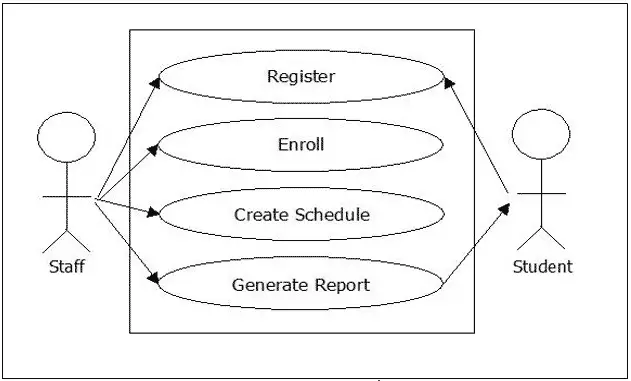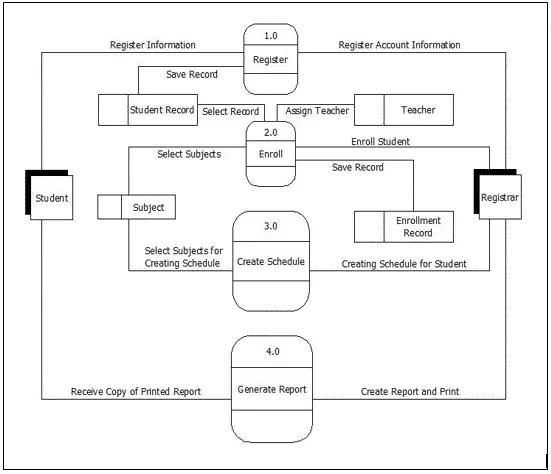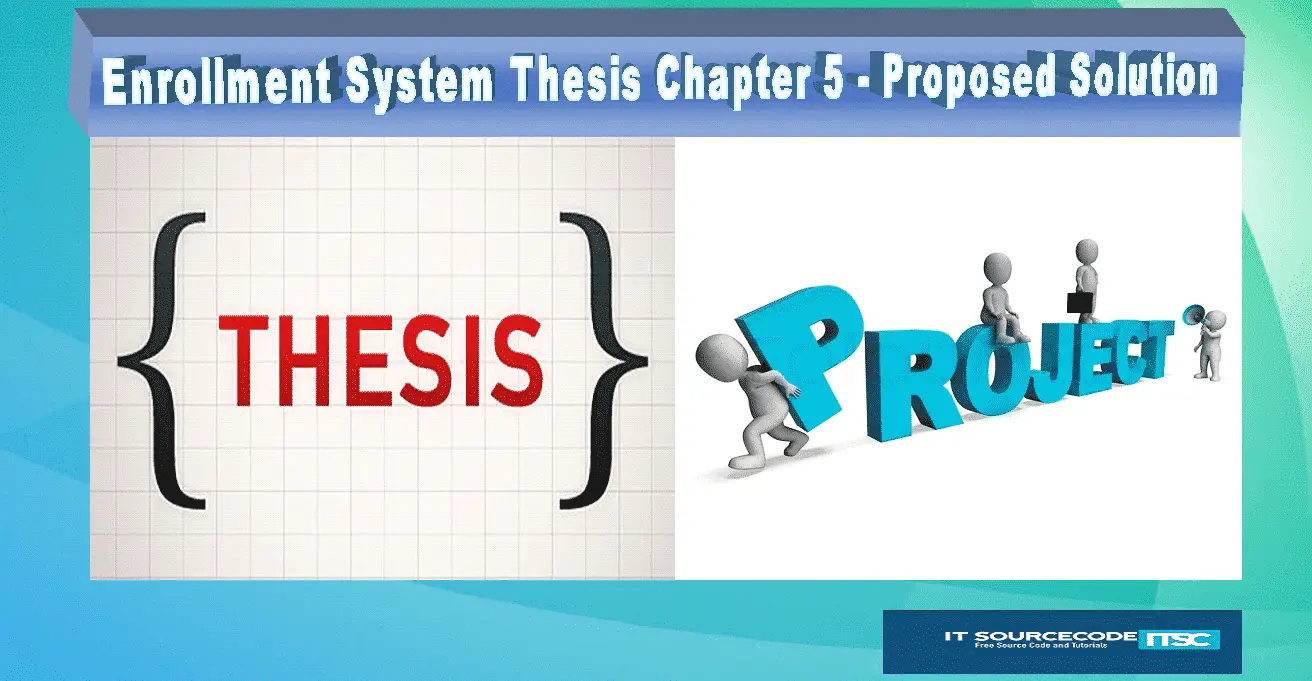Enrollment System Thesis Chapter 5 – Proposed Solution
The Enrollment System Thesis Chapter 5 – Proposed Solution or (Chapter 5 Thesis Project for Enrollment System) ,Will includes all the detailed records about the entire study (Computerized Enrollment System Documentation Chapter 5), this can include the Proposed solution, Scope of the Solution, Concept of Operation, Use Case Diagram, Use Case Description, Data Flow Diagram of the Proposed System, Data Dictionary, Class Diagram, Entity Relationship Diagram, Advantages, Disadvantages, Technical Feasibility, Social and Operational Feasibility and Economical Feasibility Line-Heigh .
Here’s the Outline of Enrollment System Thesis Chapter 5 – Proposed Solution
Enrollment System Thesis Chapter 5
- Proposed Solution
- Scope of the Solution
- Concept of Operation
- Use Case Diagram
- Use Case Description
- Data Flow Diagram of the Proposed System
- Data Dictionary
- Class Diagram
- Entity Relationship Diagram
- Advantages
- Disadvantages
- Technical Feasibility
- Social and Operational Feasibility
- Economical Feasibility Line-Heigh
Enrollment System Thesis Chapter 5 – Proposed Solution : Proposed Solution
The Computerized Enrollment System of Ilog Catholic High School created and developed for the newest process of enrollment in the institution. The system is a computer based system that has the functions to register and enroll students who are willing to study in the said institution.
The proposed system covers the problems that the institution encountered during the use of manual system such as human errors in filling up the registration forms, unsecured storage of students record, and time consuming.
The ICHS will be the beneficiary of the proposed system for the development and improvement of the process of enrollment because it was created with the technology of the new generation and will lessen the time of the school in enrollment process. (Enrollment System Thesis Documentation Chapter 5)
Enrollment System Thesis Chapter 5 – Proposed Solution : Scope of the Solution
The proposed system was created based on the demand of the students and also of the teachers in the institution; (Chapter 5 Thesis Project for Enrollment System) the system provides the management of registration of the students with specific information for the staff to easily search the record of the students.
Enrollment System Thesis Chapter 5 – Proposed Solution : Concept of Operation
The Computerized Enrollment System starts with the registration of the student and the registration of the account of the staff to be login to the system. After the registration, the staff will select the record of the student to be enrolled.
The staff will only be the one to manipulate in updating and deleting the records of the student. The staff can search the record of the student by his ID or Family Name.
After enrolling, the student will check the schedule of all the subjects that are assigned for him for the whole year. (Enrollment System Thesis Documentation Chapter 5)
After checking the availability of the schedule of the subjects, the staff will generate a report and will provide a copy for the student.
This generated report may be generated from the enrollment details, student information overview, and the subjects that are intended for the student in the whole academic year. (Enrollment System Thesis Documentation Chapter 5)
Enrollment System Thesis Chapter 5 – Proposed Solution : Use Case Diagram

Actors: Student, Staff
The corresponding use cases for these actors are:
- Student: Inquire for registration, received a copy of printed reports.
- Staff: Inquire for registration for accounts, select a record of a student to enroll, create schedule for subjects in the whole academic year, and generate reports from enrollment details, student information overview, and the list of subjects of the student. (Chapter 5 Thesis Project for Enrollment System)
Enrollment System Thesis Chapter 5 – Proposed Solution : Use Case Description
The tables below describe all the functions, conditions, and exceptional flows to meet all the entities used in the use case diagram.
Table 1. Register
| Use Case Name: | Register |
| Primary Actors: | Staff, Student |
| Description: | The student will register to collect all the information that the staff needed for enrollment. |
| Stakeholder and Interests | Student – wants to register for enrollment. Staff – responsible on keeping the records of the students registered in the institution. |
| Pre-condition: | The student must complete the registration form. |
| Post-condition: | The staff will select one record of a student to use for enrollment.The staff will update the record of the student time by time. |
| Exceptional Flow: | The registration form of the student is incomplete. |
Table 2. Enroll
| Use Case Name: | Enroll |
| Description: | The staff will use the details of the student in the registration form for enrollment process. |
| Pre-condition: | The details of the student in the registration form in complete.The subject details are intended for the selected grade level.The information of the teacher selected for teaching the subject is complete. |
| Post-condition: | The staff will use the student details for enrolling.The staff will select subjects for the student according to its grade levelThe staff will assign teacher for the subjects’ selection of the student. |
| Exception Flow: | The student information record is deleted.The subjects selected for the student are for the other grade level. |
Table 3.Create Schedule
| Use Case Name: | Create Schedule |
| Description: | Creating schedule for the subjects intended for the whole school year. |
| Pre-condition: | The selected subject for creating the schedule is scheduled correctly. |
| Post-condition: | The staff will select subjects and create scheduleThe staff will assign the date for the subjectThe staff will set the time for the subject |
| Exception Flow: | The selected subject in the schedule must not conflict to the schedule of other subjects |
Table 4: Generate Report
| Use Case Name: | Generate Report |
| Description: | Generating reports of students information and accounts details |
| Pre-condition: | The information of the student and the records of the students enrolled is complete |
| Post-condition: | The staff will generate a report for the review of the student’s information registration The staff will generate a report for the account credentials for the whole school year |
| Exception Flow: | Wrong details in generating reports. |
Data Flow Diagram of the Proposed System
Figure 5: Ilog Catholic High School Proposed System Data Flow Diagram shows the Proposed System Data Flow Diagram of the Ilog Catholic High School. First, the student must register his personal information and will be saved in the student record database (Computerized Enrollment System Documentation Chapter
5). After the student’s registration, the staff will select one record of the student and will use it for enrollment. In the enrollment process, the staff will select subjects for the students in the school year. At the same time will assign the teacher for the subjects.
And then, the staff will create schedule for the student. Finally, the staff will generate a report from enrollment and will provide the student a copy of the printed report that the staff created. (Chapter 5 Thesis Project for Enrollment System)

Enrollment System Thesis Chapter 5 – Proposed Solution : Data Dictionary
The tables below shows the list of conceptual databases based on the computer-based enrollment system. It shows the attributes/ field name, description, data types and the length to be included in the database. This ensures that the information needed was captured by the different databases. (Enrollment System Thesis Documentation Chapter 5)
Table 5: schedule
| Field Name | Description | Type | Length |
| SCHED_ID (pk) | Database ID Number | int | 11 |
| SUBJ_ID | Subject’s Database ID Number | int | 11 |
| ROOM_ID | Room’s Database ID Number | varchar | 11 |
| AY | Academic Year | int | 20 |
| SUBJ_DAY | Schedule Day | varchar | |
| SUBJ_TIME | Schedule Time | time | 6 |
Table 6: teacher
| Field Name | Description | Type | Length |
| TEACH_ID (pk) | Database ID Number | int | 11 |
| FULLNAME | Teacher’s Full Name | varchar | 50 |
| ADDRESS | Home Address | varchar | 100 |
| SEX | Gender | varchar | 10 |
| STATUS | Civil Status | varchar | 30 |
| Email Address | varchar | 40 |
Table 7: room
| Field Name | Description | Type | Length |
| ROOM_ID (pk) | Database ID Number | int | 11 |
| ROOM_NAME | Room Name | varchar | 30 |
| ROOM_DESC | Room Description | varchar | 50 |
Table 8: staff
| Field Name | Description | Type | Length |
| STAFF_ID (pk) | Database ID Number | int | 11 |
| POSITION | Staff Position | varchar | 30 |
| FULLNAME | Staff’s Full Name | varchar | 50 |
| ADDRESS | Home Address | varchar | 100 |
| SEX | Gender | varchar | 10 |
| STATUS | Civil Status | varchar | 30 |
| Email Address | varchar | 40 | |
| ACC_USER | Staff’s Password Username | varchar | 50 |
| ACC_PASS | Staff’s Account Password | varchar | 50 |
Table 9: subjects
| Field Name | Description | Type | Length |
| SUBJ_ID (pk) | Database ID Number | int | 11 |
| SUBJ_CODE | Subject Code | varchar | 30 |
| SUBJ_DESC | Subject Description | varchar | 100 |
| YEAR_LEVEL | Year Level | varchar | 20 |
Table 10: student
| Field Name | Description | Type | Length |
| STUD_ID (pk) | Database ID Number | int | 11 |
| FNAME | First Name | varchar | 30 |
| LNAME | Last Name | varchar | 30 |
| MNAME | Middle Name | varchar | 30 |
| SEX | Gender | varchar | 10 |
| BDATE | Birth Date | varchar | 30 |
| BPLACE | Birth Place | varchar | 100 |
| STATUS | Civil Status | varchar | 30 |
| AGE | Age | int | 3 |
| NATIONALITY | Nationality | varchar | 30 |
| RELIGION | Religion | varchar | 30 |
| CONTACT_NO | Contact Number | varchar | 20 |
| HOME_ADD | Home Address | varchar | 100 |
| Email Address | varchar | 40 | |
| FATHER_FULLNAME | Father’s Full Name | varchar | 50 |
| FATHER_OCCU | Occupation | varchar | 50 |
| MOTHER_FULLNAME | Mother’s Full Name | varchar | 50 |
| MOTHER_OCCU | Occupation | varchar | 50 |
| GUARDIAN_FULLNAME | Student Guardian’s Full Name | varchar | 50 |
| GUARDIAN_ADD | Guardian’s Address | varchar | 100 |
| GUARDIAN_CONTACT_NO | Guardian’s Contact Number | varchar | 20 |
Table 11: enrollment
| Field Name | Description | Type | Length |
| ENROLL_ID (pk) | Database ID Number | int | 11 |
| AY | Academic Year | varchar | 20 |
| YEAR_LEVEL | Year Level | varchar | 20 |
| STUD_ID (fk) | Student’s Database ID Number | int | 20 |
| SUBJ_ID (fk) | Subject’s Database ID Number | int | 11 |
| DATE_ENROLLED | Date Enrolled | date | |
| STATUS | Enrollment Status | varchar | 30 |
Enrollment System Thesis Chapter 5 – Proposed Solution : Class Diagram
Figure 6: ICHS Automated Enrollment System Class Diagram shows the system entities, attributes, operations and its relationships with the other entities that perform the exact operation among each object.
Enrollment System Thesis Chapter 5 – Proposed Solution : Entity Relationship Diagram
Figure 7: ICHS Automated Enrollment System Entity Relationship Diagram shows the system entities relationships in each entity and their supposed functions in each relationship that shows the primary keys (pk) that are being used to other entities called foreign keys (fk).(Computerized Enrollment System Documentation Chapter 5)
Advantages
- Computerized
Registration of the Student - Weekly
Backup of the Database Storage - User
friendly Interface of the System - Quick
Search of the Record of the Student
Disadvantages
- Only
one (1) Student for registration only - No
password retrieval
Enrollment System Thesis Chapter 5 – Proposed Solution : Technical Feasibility
During the research study, the researchers have concluded that the study is technically feasible because all the requirements for software and hardware are already available.
So there will be no more problems in getting the required resources for the development of the system. (Chapter 5 Thesis Project for Enrollment System)
Enrollment System Thesis Chapter 5 – Proposed Solution : Social and Operational Feasibility
The proposed computerized enrollment system study is socially and operationally feasible because the proposed system is developed for the demands of the students of the institution in order for them to easily understand all the functions that this system has (Chapter 5 Thesis Project for Enrollment System).
The researchers also created the proposed system with a user friendly interface for them to operate the system easily to provide them a social and operational system that they need.
Enrollment System Thesis Chapter 5 – Proposed Solution : Economical Feasibility Line-Heigh
In the whole development of the proposed system, the researchers concluded that the study is economically feasible because the institution will not provide a large amount of budget in order to develop the whole system and make it functional.
The only thing that the institution needs to do is to make the environment capable to gain the usability of the resources that this system needs.(Computerized Enrollment System Documentation Chapter 5)

